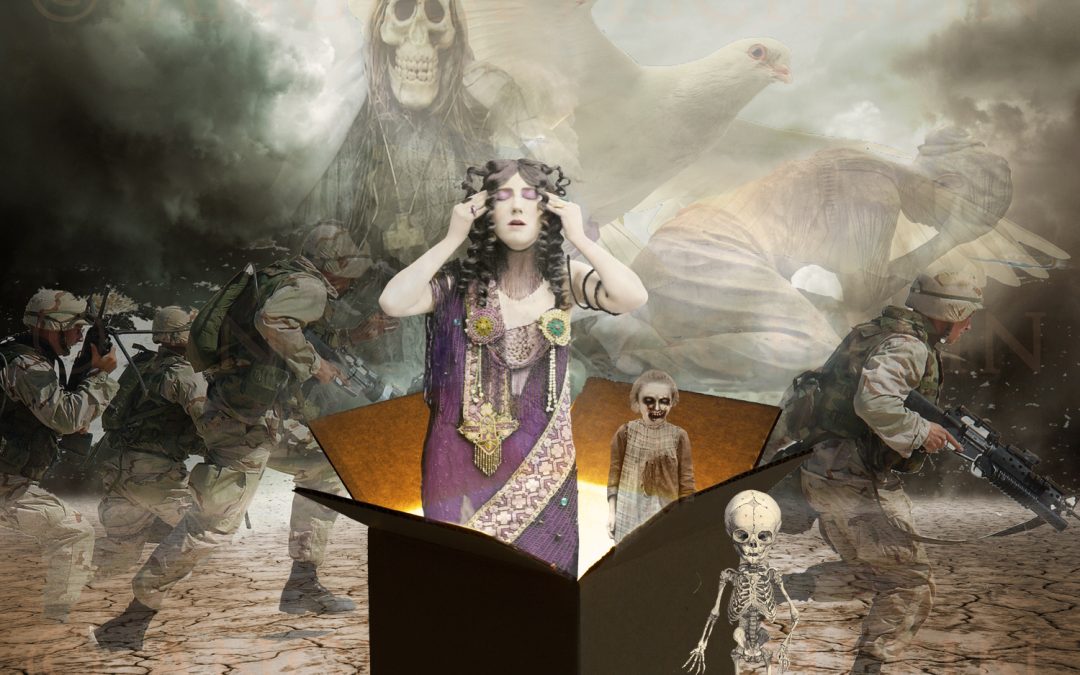Pandora is a beautiful woman made of clay, created by Hephaistos, the god of fire. Pandora is a beautiful and very curious young woman. Hephaistos was given this special assignment of creation as a punishment for Prometheus’ theft of fire, which made fire accessible to humans. Greek poet Hesiod is listed as the first author of Pandora Mythos, lending this mythology a truly patriarchal slant. Hesiod’s literary text frequently referred to women as “a curse or a burdon,” which led interpreters to position Hesiod’s work as a precursor to the misogynistic literary tradition.
According to the Chambers Dictionary, the classic phrase “the box of Pandora” means: “Any source of unexpected and great trouble.” (Brewer’s Concise Dictionary of Phrase and Fable) or “A gift that seems valuable but is actually a curse.” (Chambers Dictionary). It is only when we, as women, become aware of how deeply embedded the notion of female inferiority is within the language that we can begin to understand the significance of this connotation. The phrase “it’s best not to open the Pandora box in relation to a current event or circumstance” is a very common one and we all have used it to describe some sort of difficult situation.
According to mythology, the young woman Pandora was given a box that she was not to open under any circumstances, after she has put down roots among the humans. It was obvious Pandora had no idea that by opening the jar, “all the ills of the world” would escape – with some hope thrown in at the very bottom of the box.

We can already guess what happened next after Hermes delivered Pandora to Epimetheus, Prometheus’ brother. Despite Prometheus’ warning, Epimetheus took Pandora as his “gift from the gods,” and of course, Pandora opened the box despite being forbidden to do so. According to other stories, Pandora inspired her husband Epimetheus to open the box himself, thereby allowing all the ills of the world to enter humanity. As a result, Pandora, who was blessed by the gods with beauty, good looks, love, and numerous abilities and talents, became a source of misfortune for mankind, because she made it possible for all human shadows to escape the box. So much to the commonly known Pandora Mythos.
The subject of “hope” at the bottom of the box is discussed from a variety of perspectives. In some stories, hope remains confined in the box, while in others, the box is opened so that hope can also enter a human world.
The origin of a whole new interpretation of the Pandora Mythos may lie in the incorrect translations of the term “Pithoi” (Prof. Dr. Wolfgang Rösler, Humboldt University Berlin). The term “Pithoi” should not be translated as “a box,” but rather as “the largest clay vessel found in Greek culture.” These vessels were used to store wine, grain, and olive oil. In her role as a woman of the household, Pandora opened the vessel to gain access to the food inside. As a hope for the next harvesting season, the seeds for the next growing season were stored at the very bottom of the vessel. Prof. Dr. Wolfgang Riedel (Universität Würzburg) argues that Pandora was initially probably worshipped as a fertility goddess and as the All-Giving Goddess. Clearly, this gives us a very different picture of Pandora, even though we should not ignore the link between myth, and gender roles. If literature- and media-based gender studies continue to focus on interpretations such as “human evil” and the end of the paradisiacal era, we are on to something with regards to shifting inner and outer perceptions.
Related Literature: Pandora’s Senses, Vered Lev Kenaan (2008)
Pandora, Heinz-Peter Preußer (Hg.), Françoise Rétif (Hg.), Juliane Rytz (Hg.)(2012)
